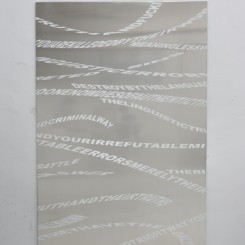Tsang Kin-Wah Solo Exhibition
Pearl Lam Hong Kong (Pedder Building, 12 Pedder Street, Hong Kong)
Ecce Homo. “Behold the man,” Pontius Pilate said to the public when he crucified Jesus Christ. The same phrase was taken by Friedrich Nietzsche for his autobiography, which he finished in the last years of his ontological pursuit. Again, Tsang Kin-Wah borrows the same words to title his latest show at Pearl Lam Gallery Hong Kong, where he reinterprets the prosecution of Romanian dictator Nicolae Ceausescu. He appropriates footage in which a sinned human figure is the protagonist, thus projecting a series of thoughts on death, violence, and belief.
The narrative of the exhibition simulates a linearity reminiscent of a religious triptych, starting with Tsang’s signature text-pattern installation, “Every Word Is A Prejudice,” which occupies the entrance room of the exhibition and functions as a prelude to the show. The swirling texts advocate and magnify words such as “Justice,” “Death,” and “Violence,” and give a synopsis to the following chapters in the adjacent rooms. Its visual form was most striking — the text ripples are seemingly emitted from an aluminum plate centered in the middle wall of the room. The quasi-symmetric composition bursting from an apparent altar and the reflectiveness of its center create a dynamic depth and a somewhat holy, immersive power.
Three videos, which make up the different stages of the prosecution of Ceausescu, are divided into three Chapters: “Trial,” “Execution,” and “Burial.” This found footage, previously viewed by millions on Youtube, was re-edited into a blurry, low-resolution black and white film texture, the coarse gains and rough progression highlighted by fluttery ghostly faces and ambiguous ambient sounds, all of which create an uncanny scenario in a dark atmosphere.
This political event is ritualized and somehow arranged romantically through a unified aesthetic filter, enkindling a religious aura. As the exhibition space is arranged to be explored unidirectionally, one would not reverse his footsteps, the path works as a life cycle, rapidly move forwards, and then disappears.
Tsang had been a Christian, but then he became a nihilist under the influence of Nietzsche and Existentialism. By putting a sinner under the same semantic spotlight as Jesus, one may derive an instance of understanding religious criticism. But one feels an ethical confusion and sympathy for the executed. In here, the possession of justice and righteousness is obscure; being holy or sinful is not the point. In the exhibition, words are too direct and narrow to be pictured, while the images are inexplicable by words. The choices of life and death should not be made by anyone. The true trial of life should not be based on others’ biases. The dramatic final of Ceausescu’s life is minimized to a mediated event that, besides its historical position as a key moment in ending the Cold War, serves as an allegory for the ambiguous cruelty of justice.
